
Which of the following structure of carboxylic acid accounts for the acidic nature
A. R—COOH
B. R—C—(OH)2
C. R—CHO
D. None of these
Answer
219k+ views
Hint: Organic compounds are those compounds that contain carbon-carbon or carbon-hydrogen bonds. Due to the catenation property of carbon, it can form long chains of compounds containing carbon and these compounds are organic compounds.
Complete Step by Step Answer:
The organic compounds are classified on the basis of the carbon chain open-chain and closed-chain compounds and aromatic compounds. Organic compounds are also classified on the basis of the functional group attached to the carbon chain for example:
Alkene if there is a double bond between the carbon-carbon bond C=C
Alcohol if the functional group is —HO
Halides if the functional group is —X (Where X can be F, Cl, Br, I)
Aldehyde if the functional group is —CHO
Ketone if the functional group is —CO—
These are some functional groups and classes of organic compounds.
R—C—(OH)2 is diol because it contains two alcoholic groups ‘ol’ is used as a suffix for the alcoholic group (—OH) hence R—C—(OH)2 is a diol example of diols-
1. Methanediol or methylene glycol
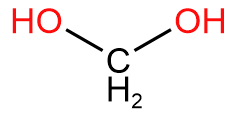
2. Ethanediol or ethylene glycol
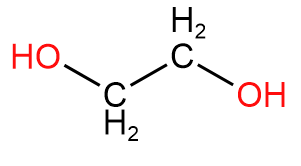
3. Cyclohexane-1,2-diol
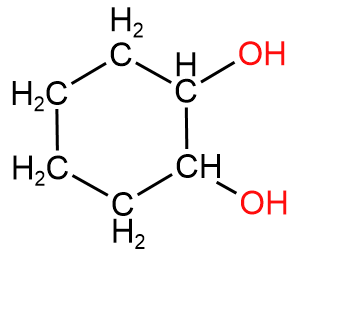
R—CHO is an aldehydic group, it is also known as the carbonyl group as it contains the C=O group. Examples of aldehydes are-
1. Methanal or Formaldehyde
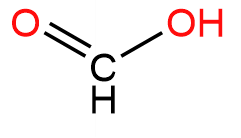
2. Ethanal or Acetaldehyde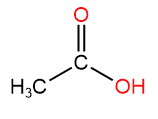
3. Benzenecarbaldehyde or benzaldehyde
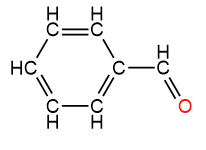
R—COOH is a carboxylic acid group, it is acidic in nature because on dissociation it gives R—COO- and H+ ions in the solution:
Examples of carboxylic acid:
1. Ethanoic Acid or Acetic acid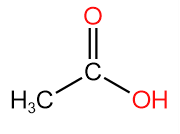
2. Methanoic Acid or Formic acid

3. Oxalic Acid

4. Salicylic Acid
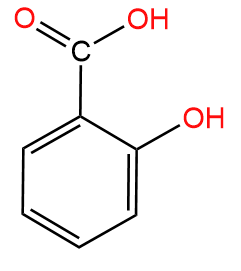
Hence we know that the carboxylic group is R—COOH.
Thus, Option (A) is correct
Note: Most of the Carboxylic acid occurs naturally for example in insects like ants formic acid is found, caprylic acid in coconuts, and oxalic acid in oxalis. Carboxylic acids are weak acids compared to inorganic acids like HCl, H2SO4, HNO3, etc.
Complete Step by Step Answer:
The organic compounds are classified on the basis of the carbon chain open-chain and closed-chain compounds and aromatic compounds. Organic compounds are also classified on the basis of the functional group attached to the carbon chain for example:
Alkene if there is a double bond between the carbon-carbon bond C=C
Alcohol if the functional group is —HO
Halides if the functional group is —X (Where X can be F, Cl, Br, I)
Aldehyde if the functional group is —CHO
Ketone if the functional group is —CO—
These are some functional groups and classes of organic compounds.
R—C—(OH)2 is diol because it contains two alcoholic groups ‘ol’ is used as a suffix for the alcoholic group (—OH) hence R—C—(OH)2 is a diol example of diols-
1. Methanediol or methylene glycol

2. Ethanediol or ethylene glycol

3. Cyclohexane-1,2-diol

R—CHO is an aldehydic group, it is also known as the carbonyl group as it contains the C=O group. Examples of aldehydes are-
1. Methanal or Formaldehyde

2. Ethanal or Acetaldehyde

3. Benzenecarbaldehyde or benzaldehyde

R—COOH is a carboxylic acid group, it is acidic in nature because on dissociation it gives R—COO- and H+ ions in the solution:
Examples of carboxylic acid:
1. Ethanoic Acid or Acetic acid

2. Methanoic Acid or Formic acid

3. Oxalic Acid

4. Salicylic Acid

Hence we know that the carboxylic group is R—COOH.
Thus, Option (A) is correct
Note: Most of the Carboxylic acid occurs naturally for example in insects like ants formic acid is found, caprylic acid in coconuts, and oxalic acid in oxalis. Carboxylic acids are weak acids compared to inorganic acids like HCl, H2SO4, HNO3, etc.
Recently Updated Pages
Is PPh3 a strong ligand class 12 chemistry JEE_Main

Full name of DDT is A 111trichloro22bispchlorophenyl class 12 chemistry JEE_Main

Sodium acetate on heating with soda lime produce A class 12 chemistry JEE_Main

Find the isoelectric point pI of Lysine A 556 B 974 class 12 chemistry JEE_Main

The order of basicity among the following compounds class 12 chemistry JEE_Main

The number of isomers in C4H10O are a7 b8 c6 d5 class 12 chemistry JEE_Main

Trending doubts
JEE Main 2026: Application Form Open, Exam Dates, Syllabus, Eligibility & Question Papers

Derivation of Equation of Trajectory Explained for Students

Hybridisation in Chemistry – Concept, Types & Applications

Understanding the Angle of Deviation in a Prism

Understanding Collisions: Types and Examples for Students

Understanding Atomic Structure for Beginners

Other Pages
NCERT Solutions For Class 12 Chemistry Chapter 1 Solutions - 2025-26

NCERT Solutions for Class 12 Chemistry Chapter Chapter 7 Alcohol Phenol and Ether

NCERT Solutions ForClass 12 Chemistry Chapter Chapter 8 Aldehydes Ketones And Carboxylic Acids

JEE Advanced Marks vs Ranks 2025: Understanding Category-wise Qualifying Marks and Previous Year Cut-offs

Haloalkanes and Haloarenes Class 12 Chemistry Chapter 6 CBSE Notes - 2025-26

Solutions Class 12 Chemistry Chapter 1 CBSE Notes - 2025-26




